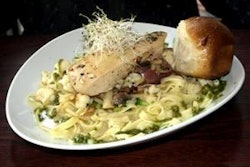The 2012 award for significant advances in humane slaughter, awarded by the Humane Slaughter Association, has gone to a group looking at more humane ways to slaughter poultry.
The Stunning and Slaughter Group at the University of Bristol’s School of Veterinary Sciences has, for over 15 years, been investigating the design and operation of the poultry waterbath stunner, as well as initially developing the use of controlled atmosphere systems, offering an alternative to the traditional multi-bird electrical stunner. “The group’s research has led to a high welfare alternative through the use of both [controlled atmosphere] and an electrical alternative that has real potential for the future,” said Dr. Becky Whay, head of the Animal Welfare and Behavior Group at the School of Veterinary Sciences.
The research into controlled atmosphere methods has paved the way for commercial development of gas slaughter systems for poultry. Although these have welfare advantages over electrical waterbath methods, as the birds do not need to be handled or shackled, electrical systems are likely to remain in use, and the group has undertaken key research into assessing the efficacy of electrical stunning and into various welfare refinements for this method.

















